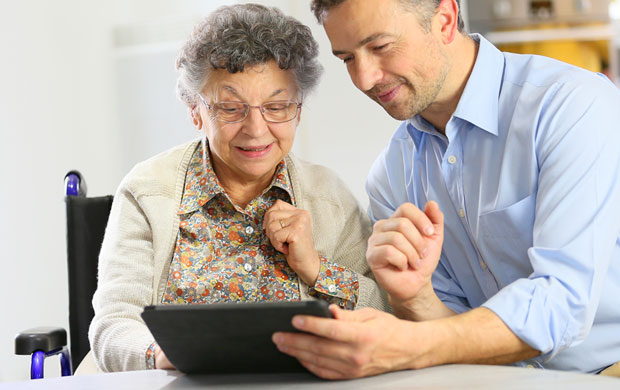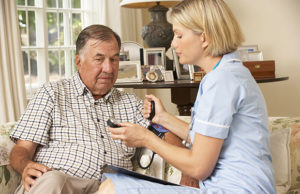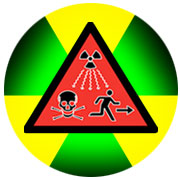The call came in less than an hour before the 8 a.m. shift was scheduled to start: A family emergency meant the regular caregiver for an elderly Dana Point, California, client couldn’t make her shift that day, so a replacement caregiver was needed ASAP.
Homewatch CareGivers of San Juan Capistrano (Calif.) had to quickly find and send a substitute from its pool of licensed, trained and security-bonded caregivers.
Once confirmed to cover the shift, the substitute caregiver tapped into the Homewatch CareGivers “Care+” mobile system to access the client’s medical information, such as client care plan and schedules for meals, medications, blood pressure monitoring, doctor visits and more.
In the mobile app, the caregiver was able to check in for the shift, confirm timesheet details, and obtain driving directions to the client’s home.
At the end of the eight-hour workday, the caregiver used the mobile app to capture end-of-shift notes and formally check out of the work period that had been scheduled so hurriedly early that morning. All the day’s client-related information and activity were recorded in the Care+ database for future reference.
Filling Homecare Gaps
Homewatch CareGivers of San Juan Capistrano began operations in 2015 as a franchised home care provider in South Orange County, California, part of the international Homewatch CareGivers franchise network.
Homewatch CareGivers of San Juan Capistrano employs 50 to 75 full- and part-time caregivers (95 percent female) serving approximately 40 clients in South Orange County. The company pursues a business model based on enabling clients to stay in their homes — wherever home may be — and allowing families to maintain a balanced living routine by providing the care needed for loved ones when family members can’t be available.
Applying technology solutions to eldercare needs is something Brad Larsen, co-owner of Homewatch CareGivers of San Juan Capistrano, strongly advocates. He works in the healthcare industry that uses the Internet in many ways to provide comprehensive, affordable services to an aging U.S. population, part of a growing trend in “digital care” for the elderly.
However, Larsen also likes to emphasize the human touch.
“Technology is great for filling in the gaps, he told TechNewsWorld, “but a warm, loving relationship between client and caregiver is what’s really most important.”
Eldercare Tech
The U.S. currently has a population of 51 million citizens age 65 and older, according to Index Mundi and the CIA Factbook. That number is expected to double by 2060.
Meeting the demands of a rapidly aging U.S. population has given rise to a multibillion-dollar home care industry serving millions of Americans who hire private-duty home care agencies and their paid caregivers to provide personal care for clients.
The introduction of technologies like the software platform that saved the day for the elderly Dana Point woman is just one of several major trends — for example, fewer nursing homes, a nursing shortage, digital senior care, home automation — currently transforming the eldercare industry.
At the forefront of these industry trends is the idea of “Aging in Place,” defined by the U.S. Centers for Disease Control and Prevention (CDC) as “the ability to live in one’s own home and community safely, independently and comfortably, regardless of age, income or ability level.”
The technology to make Aging in Place possible relies extensively on the Internet, plus a slew of smart devices and apps such as GPS location tracking on smartphones and tablets, remote monitoring of health conditions, medical alert systems, voice-activation gadgets and more.
Some examples:
Care Coordination — CaringBridge is a care-sharing tool primarily used during a health crisis. Family and friends log on to get progress reports and sign up for assignments. The iPhone and iPad app synchronizes to a website.
Medication Management Devices and Systems — On average, someone age 65-plus takes five medicines a day, according to AARP. Medication systems help aging parents stay on track — and let family members know about any disruptions. CareZone is a free app that users set to buzz the phone when it’s time to take pills. Users take a photo of a pill bottle and upload it, and the app transcribes the label and adds it to a medication list. MedMinder is a flashing, beeping digital pill dispenser with messages prerecorded in a family member’s voice. Reminder Rosie, the Personal Voice Reminder, features a talking clock.
Social Engagement Tools — grandCARE utilizes large touchscreens to enable residents at home or in long-term care to have video chats with family, get the news, play games, visit websites and more.
Other features: medication prompts, sensor monitoring, and telehealth device recording (e.g., glucose, pulse, weight, etc.). Caregivers can connect to a website portal from any Web-connected device.
GeriJoy, often used by people with mild to moderate Alzheimer’s, features a touchscreen tablet that “talks.” Tap the screen and a snoozing “virtual pet” (dog or cat) “wakes up,” and interactive chatting begins.
A remote trained staff operates and speaks through the screen. Staffers know each client’s interests and might ask knowledgeable personal questions. Family can inform remote staff about things happening on any given day.
S.O.S. Safety Devices — Personal emergency response systems (PERS) such as medic alert-like pendants and wristbands have been getting more sophisticated. These devices can be pressed during an emergency to alert family members and professionals about any problems or trouble.
Some companies, like GreatCall and MobileHelp, have mobile PERS that work anywhere, not just in a client’s home — and they include fall detection. If the PERS senses a fall, it alerts a call center even if the user hasn’t pressed the button.
Trends Transforming Eldercare
The most important demographic trend in the U.S. — and worldwide, for that matter — is that baby boomers have grown old.
According to the Population Reference Bureau (PRB), a total of 76 million births occurred in the U.S. from 1946 to 1964, usually considered the “baby boom” decades.
Before millennials outnumbered them, baby boomers were the largest generation in American history. Roughly 10,000 baby boomers now turn 65 every day, and about 10,000 more will cross that threshold every day through 2029.
The key question for boomers: Whom can they trust to help them with the aging process?
Recent trends:
Nursing Homes Decreasing in Number — At the same time that the number of older Americans has been increasing rapidly, the number of U.S. nursing homes has been declining.
The total number of nursing homes in the U.S. decreased by 9 percent from 2000 to 2009, according to CNBC. There were 15,640 nursing homes with a reported 1.7 million licensed beds serving a senior population of more than 45 million in 2014.
The state of California had the highest number of nursing homes of any U.S. state in 2015, with 1,219 facilities to serve a state population of 5.3 million adults age 65 and above.
National Nursing Shortage Increasing — There certainly are not enough nurses available to take care of all the elderly.
America’s 3 million nurses make up the largest segment of the healthcare workforce in the U.S., and nursing is currently one of the fastest-growing occupations in the country.
Despite that growth, demand has been outpacing supply. There will be 1.2 million vacancies for registered nurses between 2018 and 2022, the Bureau of Labor Statistics as forecast.
By 2025, the shortfall is expected to be “more than twice as large as any nurse shortage experienced since the introduction of Medicare and Medicaid in the mid-1960s,” a team of Vanderbilt University nursing researchers wrote in a 2009 paper on the issue.
Caregiving Options Increasingly Inadequate — Caregiving in the U.S. is “at best patchy and at worst dangerous,” reported the Financial Times last year.
The U.S. elderly care industry was dominated by more than 25,000 private groups, many of them small “mom and pop” operators that paid the federal minimum wage of US$7.25 an hour to the roughly 2.2 million people who worked as caregivers, according to the paper.
In addition to at-home care, eldercare options include public and private third-party services such as adult daycare centers, assisted living communities, and nursing homes. All of them vary in terms of services offered (and associated costs), not just from state to state, but also from city to city within each state.
Adult day programs offered at drop-in centers typically are available on weekdays during daytime hours. Assisted living facilities offer community-like settings for people who no longer live can independently without help. Nursing homes offer private rooms and semi-private rooms at different cost levels, with additional charges for various services, including meals.
Private-Duty Home
Enter “Aging in Place” and the at-home eldercare industry with professionally trained caregivers.
Because of the fragmented nature of the home care industry, it is difficult to put a dollar value on its size, although investment bank Harris Williams estimates that the industry was worth $40 billion in 2016 and will grow to almost $54 billion by 2019.
An optimum home care program features experienced, trained and supervised in-home caregivers providing personalized, one-to-one social, physical and cognitive support care and assistance with Activities of Daily Living, or ADLs.
Most adults would prefer to remain in their home of choice for as long as possible, and one-third of American households are home to one or more residents 60 years of age or older, according to AARP, which reports that 90 percent of adults older than 65 have indicated that they would prefer to stay in their current residence as they age.
Aging in Place Technology Watch
The most important trend regarding eldercare technology in the U.S. today is the movement toward smart home technology that allows control of a home’s systems without the need for touching any controls, according to Laurie Orlov, principal analyst at Aging in Place Technology Watch.
Aging in Place Technology Watch is a Port St. Lucie, Florida-based market research firm that provides thought leadership, analysis and guidance about technologies and services that enable boomers and other seniors to remain longer in their homes of choice.
Enabling older adults to control technology by using their voices reduces their dependency on keyboards, an important advantage when finger dexterity has diminished.
Some of the major problems facing the eldercare technology industry today, according to Orlov, are the following:
“The venture capital industry is not interested in the space and prefers to focus on the young,” she told TechNewsWorld, “and the largest technology companies tend not to focus on this market either, also preferring to design for the young. Moreover, there’s the often prohibitive cost of technology for older adults. Most still require WiFi in the home, and at the older age ranges, WiFi access is limited and/or costly.”
Regarding the future as boomers reach their later years, Orlov said that with greater access to WiFi, along with other lower technology costs, “older adults will benefit from many innovations under way today.”
Smart Home Solutions
Mivatek Smart Connect, in Fremont, California, markets plug-n-play smart home solutions and services. In 2017, the company launched Home8care, a collaborative care and safety provider, to meet the growing needs of remote monitoring of the elderly at home. Mivatek developed a homecare system that integrates sensor and video recording technologies for fall detection and medication adherence purposes.
All issues regarding eldercare technology are critical, regardless of where the care is delivered, according to Joe Liu, CEO of Mivatek Smart Connect and Home8care.
However, “the aging-in-place trend — which allows seniors to remain in their homes for as long as possible, safely and independently — is currently the most significant catalyst of eldercare technology,” he told TechNewsWorld.
Eighty-seven percent of adults age 65-plus want to stay in their current home and community as they age, Liu said, citing AARP statistics. However, since many elderly persons will not be physically able to do so unassisted, the technologies to enable these seniors to age in place is of paramount importance.
“The technology needed is varied, and includes a multitude of devices that can keep our elders connected, protected and feeling safe at home,” Liu noted. “This includes interactive video, security, safety monitoring, medication adherence reminders, medication dispensers, activity trackers, panic and fall alerts, and emergency alert services.”
While the eldercare technology industry has been booming, there are distinct challenges that must be overcome, according to Liu.
“Chronic diseases, some of which will not respond to current treatment or cannot be monitored through current technology, are an issue,” he said, “and the cost to develop technologies that do work on these diseases is prohibitive.”
Also, “for those elders who are aging in place, privacy is an important issue,” Liu said.
“Many elderly people do not want to be monitored or watched, feeling it is an invasion of privacy,” he observed. “Thus, eldercare devices must either be small and unobservable or, in the case of wearables, very lightweight and barely noticeable.”
In addition, many eldercare devices are still only point-to-point solutions.
“It is important that eldercare devices are fully connected, so that everyone — caregivers, first responders, neighbors, etc. — can all be connected to an older person in a medical emergency for the quickest and most effective response, and thus the best outcome,” Liu said.
As for the future?
In the next few years, as well as over the long term, eldercare technology will be fully connected and automated, according to Liu.
“It will not only provide healthcare monitoring per se, but will tie into a home’s total automation ecosystem,” he said. “This is already happening now — a sensor on a refrigerator can let a caregiver know whether the senior living at home is eating regularly.”
Or a smart door lock that hasn’t been opened for a while can be cause for concern, as it might mean the elderly person hasn’t left the house for days, may have missed a doctor’s appointment, or may even be in trouble.
“In addition, emergency monitoring technology and alert services will be more popular,” predicted Liu, “as will wearable, preventive healthcare monitoring technology.”






















































This advertisement seems to be presented as a news article. While it is informative its primary intent is clearly to promote a market segment. In addition, some statements are disputed by other sources. For instance, the National Center for Assisted Living states that the total number of assisted living beds represented by members increased 13,701 over the course of last year going from 217,003 to 230,704.